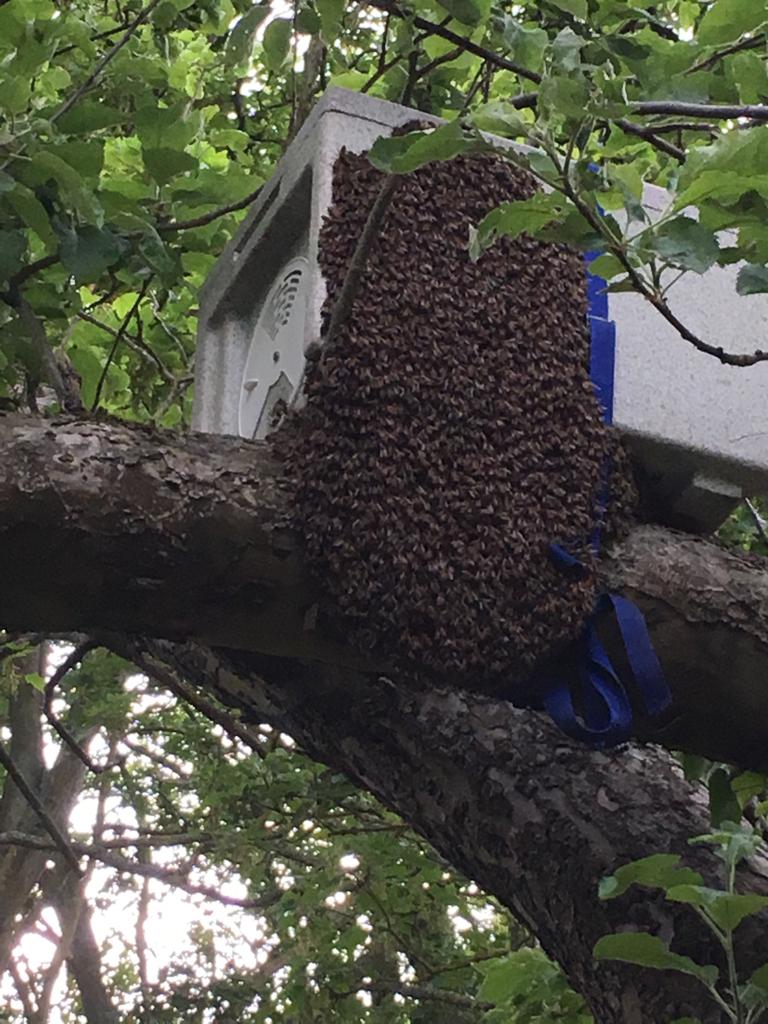Honey bee swarm collection video on our social media site
Back story.
The back story
This week we had a call out for a honeybee swarm on our bait hive. We have a bait hive at the property to attract swarms to it rather than the property itself. We have done this because many, many swarms have taken up residence at this property in the past – we call it a high traffic swarm area. This is the first time we have been involved in this property and thanks goes to Wayne from another local pest company for passing the job over to us so that these bees could have the best chance of survival, rather than being destroyed by previous or future companies for the sake of a few quid saved. The owner of the property frequently has family visiting who are so allergic to honeybees that they cannot even go near honey (before this I didn’t even know that was a thing). A simple solution is to try to intercept any swarms at the boundaries.
At the time of arrival, the swarm had chosen to settle on the outside and under the nucleus box (a small six framed starter hive or swarm collection box).
We met our beekeeper at this swarm collection after consulting via a phone call and viewing pictures sent over. The reason was due to the size, the fact they had been there for over 24 hours, the way in which they had settled and the height involved. This was not a simple place a box underneath and brush them in quickly undertaking.
Anyway, let’s get back to the video. The video showed our local beekeeper (Filipe Salbany from the bee.watch apiary as featured in this month’s Professional Pest Controller (PPC) magazine). With a vast amount of knowledge gained from beekeeping in multiple countries worldwide and keeping bees since the age of six and now for over 40 years (we're not gonna tell you how long exactly as he may not like his age published haha). He has a better understanding of bees than any other beekeeper we have spoken to and we can view his passion for bees daily by visiting the apiary. This is why we choose him as our bee consultant. If we moved to Africa or even America or in fact anywhere in the world we would still consult with Filipe.
The video shows Filipe, in a beekeeping top half suit, no gloves and unhooded with bees all over his trousers and hand. Many have said this is crazy however there is a method to that madness.
Although a scary site when arriving, swarms are not actually interested in stinging, they want to find a place to settle, build comb and, as their first priority, protect the queen.
In the video they had already settled and this is where it became fun for collection. We had to put a larger box – the bottom section of a national hive – on top of the bait hive as the swarm had already deemed the poly nucleus too small. If it hadn’t, the bees would have already moved in.
After using a smoker to encourage a good amount of worker bees to enter this new hive above them, it was time to lower both the hive and the nucleus still containing the rest of the swarm onto its side. A sheet was placed on the ground and the rest of the swarm shaken onto it from the poly nucleus. The nucleus was then placed on the floor with the sheet being placed over it and the national hive on top. This is done so the bees can walk up the sheet and into the hive. This was not what happened in this situation, however, as the bees stayed where they were, apart from the ones who took to the air. After five minutes of searching for the queen, Filipe noticed the bees in the air settle back on the branch with the wax on (an unshakeable branch at that). He climbed the ladder and applied a gentle smoke and, after a few minutes, the bees decided his jacket was the next best place to land with hundreds of bees touching down on it fast. This was a sign that the queen had landed on him and the rest followed.
Fist of furies
After Filipe climbed back down, it was then a careful game of finding the queen amongst the rest and after gently going through them we found her. She was thin, long and very dark and we were told that she was a virgin (unmated) queen. She liked taking to flight so the whole ladder climbing, branch-smoking and combing the swarm procedure had to be carried out twice. Once down the second time, Filipe managed to encourage the queen into his hand and all the bees on his jacket followed soon after.
It looked like a comic book superpower – one normal hand and one of bees. The bees were then shaken off Filipe’s hand into the hive, the lid placed on and then, within the hour, those bees still on the sheet came running, literally. Swarm now happily in the box ready for full removal a couple of hours later leaving as few bees behind as possible.
Well, that’s the story, two hours of work compressed into a few short paragraphs. Let us know what you think.
If you want to know more about www.bee.watch there is a three-page piece in the latest issue of the BPCA’s (British Pest Control Association) PPC magazine and on their websites.
If you want more info on bumblebees we recommend visiting the bumblebee conservation trust with a downloadable file half way down our homepage.
We hope you enjoyed this and stay tuned for our next fun adventure
Thank you for reading
The Shire Pest team.
All Rights Reserved Shire Pest Solutions

